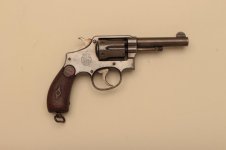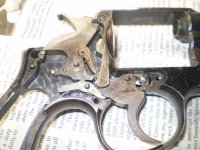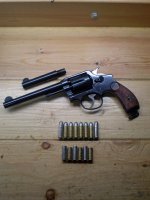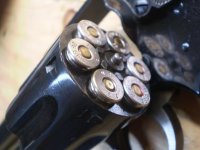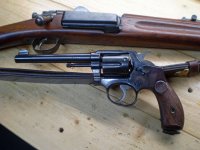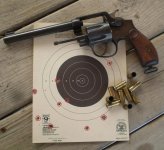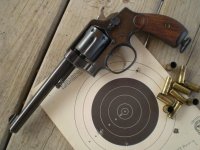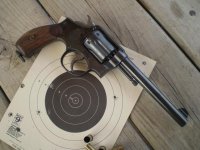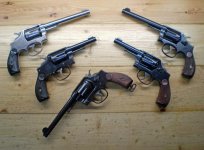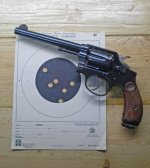I was able to pick up my first Model 1899 US Army at an auction last month and, as usual, I set about to learn everything about this US Military contract gun, some info that seems to have never been confirmed until now.
The Model 1899 has become one of my favorite S&W models to collect. I learned very early that there were rare US Army and US Navy guns out there, totally only 1,000 each made. One obvious question is how many are left? I have posed that question to our resident experts, and there average estimates were less than half would be a reasonable number. This was a model that I assumed I would never find in my budget for sale. Watching as many as I could find for sale, they have been averaging from $1500 to $2500 at various auctions. Well, I found a slightly challenged example at auction. The major challenge was that the barrel had been cut to 4”. The job was nicely done, but I wondered what diabolical mind would disfigure such a rare example of US Military & S&W history? Anyway, I put in a low bid and let it slide. To my surprise, I received an email that I had won the gun for $350, plus buyer’s premium and shipping, came to around $450. Happy with the purchase, but it was soon to get much better.
My ambition is always to put things right with the S&W world and for this model it meant finding a 6” Model 1899 barrel. There were only just over 20,000 of this model made in 38, which included the two military contracts. There were also just over 5,300 made in 32 Winchester. The US Army contract basically were made in the 13,000 serial number range and the US Navy was the 5,000 s/n range. The Navy’s shipped in 1900 and the Army contract shipped in 1901. Both was service in the Philippine-American War, 1899 to 1902. These revolvers along with the Krag rifles and Springfield Trapdoors were instrumental to the US winning the war.
Back to my new old Model 1899 US Army. I totally cleaned the gun, disassembling it to polish off what little rust was found on the mechanism, but was surprised how clean it looked inside - love the jeweling on the inside of the frame. I was corresponding with Mike Priwer who is very well schooled on collecting Model 1899s. He has posts many of his projects, while sharing his knowledge about this model, which helped me gain a great interest in the K frame 1st Hand Ejector made by S&W. Just so happened he had a spare barrel from a US Army Contract stamped with serial number 13041, while mine was 13417. It seems that he had obtained it from Bill Orr years ago and never used it. I was fortunate to obtain perhaps the only US Army 1899 barrel in existence. Now, fitted to the gun, it makes the search worth it and thanks to Mike, it is now configured properly, with original numbered stocks and a 6” barrel.
One thing I did not know was these revolvers, unlike the commercial examples of the time did not take 38 Special rounds. I assumed that after I got the gun, I would just grab some of my light reloads and head off to the range, but they did not chamber. Mike and I discussed this and he ultimately asked Roy Jinks about the issue to learn that ALL US Military 1899s were chambered only in 38 US Service Cartridge, which S&W called 38 Military (38 MIL barrel stamp). This cartridge was the 38 Long Colt round, which was about 1/8” shorter than the 38 Special. This was an important learning for me as well as collectors of this model, since many were likely rechambered for 38 Special as the round gained popularity. According to the thread started by Mike on the SWCA member side of the Forum, the US Military 1899s were chambered only in 38 Long Colt. Well, enough prattle, here is my US Army Model 1899. This fact makes the 38 Long Colt one of the rarest calibers ever to be produced by the S&W factory. There is evidence that some very early commercial Model 1899s were also chambered in this caliber, but with the advent of the 38 Special very early in the 1899s production run, the numbers of 38 LC examples produced for public sales are probably very small.
A lesson to all who think they will never be able to own a prized S&W model, it can and does happen!
The Model 1899 has become one of my favorite S&W models to collect. I learned very early that there were rare US Army and US Navy guns out there, totally only 1,000 each made. One obvious question is how many are left? I have posed that question to our resident experts, and there average estimates were less than half would be a reasonable number. This was a model that I assumed I would never find in my budget for sale. Watching as many as I could find for sale, they have been averaging from $1500 to $2500 at various auctions. Well, I found a slightly challenged example at auction. The major challenge was that the barrel had been cut to 4”. The job was nicely done, but I wondered what diabolical mind would disfigure such a rare example of US Military & S&W history? Anyway, I put in a low bid and let it slide. To my surprise, I received an email that I had won the gun for $350, plus buyer’s premium and shipping, came to around $450. Happy with the purchase, but it was soon to get much better.
My ambition is always to put things right with the S&W world and for this model it meant finding a 6” Model 1899 barrel. There were only just over 20,000 of this model made in 38, which included the two military contracts. There were also just over 5,300 made in 32 Winchester. The US Army contract basically were made in the 13,000 serial number range and the US Navy was the 5,000 s/n range. The Navy’s shipped in 1900 and the Army contract shipped in 1901. Both was service in the Philippine-American War, 1899 to 1902. These revolvers along with the Krag rifles and Springfield Trapdoors were instrumental to the US winning the war.
Back to my new old Model 1899 US Army. I totally cleaned the gun, disassembling it to polish off what little rust was found on the mechanism, but was surprised how clean it looked inside - love the jeweling on the inside of the frame. I was corresponding with Mike Priwer who is very well schooled on collecting Model 1899s. He has posts many of his projects, while sharing his knowledge about this model, which helped me gain a great interest in the K frame 1st Hand Ejector made by S&W. Just so happened he had a spare barrel from a US Army Contract stamped with serial number 13041, while mine was 13417. It seems that he had obtained it from Bill Orr years ago and never used it. I was fortunate to obtain perhaps the only US Army 1899 barrel in existence. Now, fitted to the gun, it makes the search worth it and thanks to Mike, it is now configured properly, with original numbered stocks and a 6” barrel.
One thing I did not know was these revolvers, unlike the commercial examples of the time did not take 38 Special rounds. I assumed that after I got the gun, I would just grab some of my light reloads and head off to the range, but they did not chamber. Mike and I discussed this and he ultimately asked Roy Jinks about the issue to learn that ALL US Military 1899s were chambered only in 38 US Service Cartridge, which S&W called 38 Military (38 MIL barrel stamp). This cartridge was the 38 Long Colt round, which was about 1/8” shorter than the 38 Special. This was an important learning for me as well as collectors of this model, since many were likely rechambered for 38 Special as the round gained popularity. According to the thread started by Mike on the SWCA member side of the Forum, the US Military 1899s were chambered only in 38 Long Colt. Well, enough prattle, here is my US Army Model 1899. This fact makes the 38 Long Colt one of the rarest calibers ever to be produced by the S&W factory. There is evidence that some very early commercial Model 1899s were also chambered in this caliber, but with the advent of the 38 Special very early in the 1899s production run, the numbers of 38 LC examples produced for public sales are probably very small.
A lesson to all who think they will never be able to own a prized S&W model, it can and does happen!
Attachments
Last edited:

